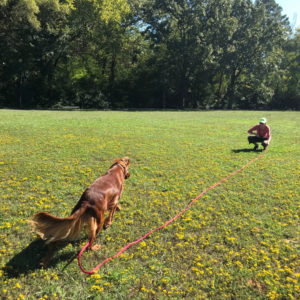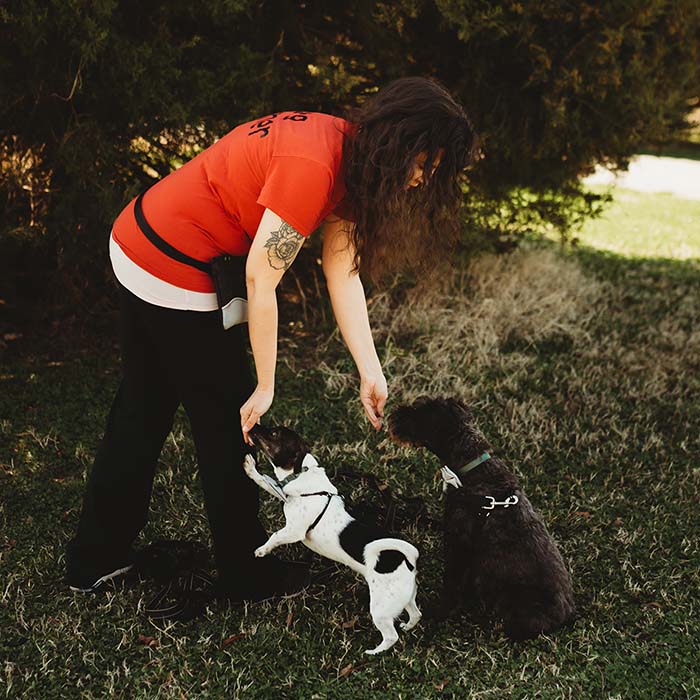Rules for The New Guy
Figuring out expectations when bringing a new dog home
My dog did nothing to prepare me for when my sister decided to bring home an 89-pound Cane Corso that had failed adoption twice.
My dog, Jeeves, is twenty pounds of eccentric miniature schnauzer, and we worked hard to be a little odd and to avoid some of the common issues of living with a schnauzer. He’s been through basic obedience, Canine Good Citizen, and intro to agility with me. We do walks and training. He has some separation anxiety, but he mainly just barks if he wants to be near me and I’m on the other side of the door or something.
I even thought he wouldn’t pass his CGC five years ago because he couldn’t handle me giving the leash to someone else and walking away.
He passed, though. I’m not quite sure how, but we did it.
I think the best way to describe him is more typical, perhaps even a standard experience when it comes to dogs.
I didn’t quite understand aggression or behavior issues until I signed on with Philly Unleashed in 2017, which provides training on a farm to dogs who wouldn’t do well in a traditional kennel. By the time I left the farm to move to Arkansas, I’d worked with plenty of dogs who needed some sort of management for their behavior. We did get a fair amount of dogs with no issues. Their owners simply wanted the best, most interactive experience for their dogs.
But the set-up at the farm worked especially well for dogs with some quirks. They received two training sessions and two leisure activities a day, which often included playtime, agility, or hikes. If they didn’t get along with other dogs, they got one-on-one with people, and we had quite a few of those sorts, and we could cater to them easily. We even had a dog or two that didn’t like certain people, for no particular reason.
I slowly, over the course of my time there, started to realize that other people had very different experiences than my own.
It wasn’t until I was faced with the personal challenge of Maslow that I got it. If you pop on over to my writing website, you’ll see that I didn’t want the Cane Corso with the orange eyes, not even a little bit. There were issues I couldn’t explain.
But my sister believed in him.
So I made the rules.

Before You Bring Your Dog Home
- Remember it might take time for your dog to settle in.
- Research the breed.
- Consider your expectations–and bring in a professional if there are struggles with communication.
(Here’s an additional blog post by the owner/certified dog trainer of Philly Unleashed, Nicole Skeehan, that covers some additional points. Nicole has owned Philly Unleashed since 2011 and has grown the company from just her to about 15 employees. I learned how to be a dog trainer at the Philly Unleashed farm, and I continue to edit and write for her monthly, which has been a fun way for me to stay connected with this fabulous group of people after my move 18 hours away.)
I needed Maslow to settled in gradually, which included a slow introduction to my dog. And my priority was keeping everyone in the house, both human and canine, safe.
With those goals in mind, Corso research, and all the feedback from others rattling around, I made some rules.
My Rules for Maslow
1. He was to be on leash the first three days.
To minimize confusion and ease him into his new situation, we kept him on leash the first few days. This helped him recognize who was part of the household and who wasn’t, and prevented him from charging anyone who startled him.

2. He and Jeeves were to be introduced slowly over the course of a week.
My dog is small and feisty, and Maslow has a prey drive. Maslow was able to get used to the smell and presence of Jeeves while he settled into his new home long before they ever met. Now, Maslow is still a bit rude, but they live together well.
3. Children could not lay down on the floor or be alone with him.
Cane Corsos are notoriously large and rough.

When Maslow gets uncomfortable or overstimulated, he may hump. We found that keeping people off of the floor helped reduce that humping urge, especially as he settled in. Because children tend to be small, we wouldn’t allow any, whether my nephew or his friends, to be alone with him. We weren’t afraid he’d purposefully harm them, but due to his size and rough play, we didn’t want to risk a well-intentioned game go awry.
4. There was no wrestling with him or playing tug of war.
Roughhousing with Maslow amped up his behavior quickly, so we kept to calm games, like fetch. He’s so strong that one pull can really wretch the arm.
These rules helped guide and manage Maslow’s behavior while keeping everyone safe, even from an accidental whoops, like him not realizing how strong he is.
I was also determined to not using force at all with him. He doesn’t handle it well. Some might label him “dominant” as a result, and that’s a common term thrown around these parts. While I would certainly say that Maslow has his preferences, the term “dominant” has often been misused over the past ten years and tends to suggest needing the use of force in return. For a scholarly examination, I recommend Patricia McConnell’s The Other End of the Leash. She discusses at length how dominant and submissive are actually useful terms, but there’s rarely all or nothing in regards to common understanding. A dog that might guard a food bowl might not care at all about keeping his spot on the couch.
And Maslow falls into that sort of grey. He will simply yell at Jeeves for touching his food bowl. He’ll trade his stolen shoes for cheese. But he will not abide being manhandled, so I pay attention to that. I’d rather we have clear communication and expectation first, and I’ve found that basic dog knowledge and understanding can go a bit of the way, as can understanding what a breed is like and what the individual dog may need.
These days, Maslow trots right on up to me and knocks his head against my legs, waiting for me to pet him.
We’ve come a long way.
–
Drop-in group classes take place every Saturday at SoMa Animal Clinic. I also offer private in-home lessons. Email me at info@telltaildogtraining.com for more information.



